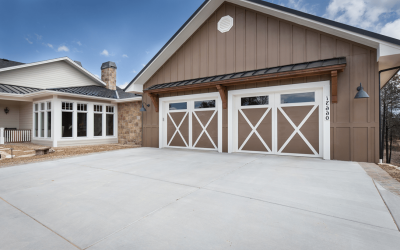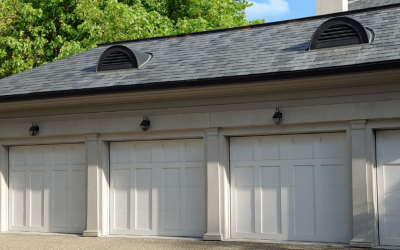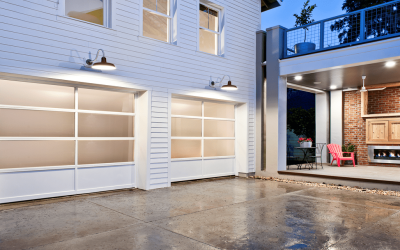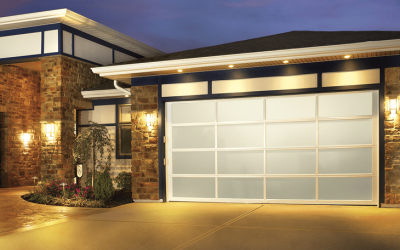Getting Started
Always Put Safety First!
Torsion spring replacement calls for the strongest of warnings. It is an extremely dangerous venture because installing the new spring puts it under tension, putting the installers at risk. Improper installation, or installation that does not incorporate use of the correct tools or the proper procedures, can result in serious injury, such as loss of limbs. Improper handling can even result in death. Following proper procedure and doing the job is your personal responsibility. If you doubt your abilities to complete the project safely and correctly, it is suggested that you hire a trained garage door technician to install the springs and repair your garage door properly.
Even experienced technicians can be injured while dealing with torsion springs. As an example, losing fingers or portions of fingers, requiring stitches and getting metal particles in the eyes are very possible when handling such jobs. It is important to remember that repairing garage doors is dangerous work. Even when following the directions precisely, it is impossible for these directions to fully address every dangerous situation that you could face while working on the project. Hopefully these directions will give you a safe start and some guidance, but remember, proceed with caution as there are no complete guarantees that these instructions will work with your project and prevent injury. Give extra attention to any warnings that are included in the instructions.
- While these things may not happen, there are two things you should assume during the repair process. You should anticipate the breaking of the garage door spring as you wind or unwind it. To prevent injury, hold the bars on the ends that are farthest away from the plugs. You could also opt to stand on a ladder that is sturdy. Do not stand on cans, buckets or chairs as they could tip over and cause you to fall. Do not wear clothes that are loose or baggy. Be sure to keep clothes and body parts clear of the spring to avoid contact or entanglement. Safety glasses should be worn throughout the process.
- The next assumption should be the idea that as you wind the spring, the plug will explode or slip. When the plug is winding, be sure to keep your head away from it. Hands should be kept away from the plugs because there is a risk that the winding bar could slip out of the plug, causing your hand to jerk up. In such situations, you want to prevent your skin from being torn or cut and you want to ensure that your clothes and appendages are not wrapped into the springs.
- Older winding cones deserve extra attention. Standard cones should be used to replace the older cones when you order a new spring. While the McKee and Crawford older cones were made with a design compatible with 5/8″ bars, the holes in them can sometimes be too small for bars of that size. If this is the case, you should never get a larger bar, such as 1/2″ for the project. Instead, go ahead and get the 5/8″ bar then grind it to the proper sizing so it will fit. It is not safe to use a bar that is sized differently than the cone calls for originally.
- Some of the older winding plugs made by manufacturers such as BarCol, Raynor or Overhead, are known for their inconsistent hole sizes. In situations such as with those brands, it is recommended that you purchase standard cones with normal hole sizes to use alongside your new torsion springs. In some instances, you can insert a 1/2″ x 18″ bar into some of the holes and then move the bar’s opposite end over about four inches. In newer cones, the bars will move less than an inch-and-a-half. Older cones have been known to spin loose from the bars, and in such cases, can inflict injury or damage. If the cones for your garage door have more than two inches of play, you need to purchase new cones or hire a professional garage door technician to handle the job.
- In order to get the project underway, get all the tools the job requires together. This job will require at least two 10-inch vise grips, two winding bars that measure 1/2″ x 18″ and an adjustable wrench. You will also need steel rods, measuring 1/2″ x 36″ that can be cut in half. These steel rods are available at most hardware stores. Other needed items include a sturdy ladder, a file, a ruler, socket wrench and sockets. The work area in the garage needs to have proper lighting so you can see how to proceed with the work.
- First, unplug the garage door opener’s power cord. If it is an older opener that has been hardwired, you may have to flip the circuit breaker or remove a fuse or two.
- Next, you should disengage the garage door opener. On some garage door openers, the trolley disconnect has a neutral position. On some openers featuring an older design, the L-shaped drawbar arm may have to be removed.
- About three inches above the rollers, you need to vise grip the vertical track. This one step can help protect you in the event you have installed the wrong springs or accidentally over-wind the spring. Otherwise, the garage door could fly up and knock you off your ladder.
- Take your old spring and measure it. Then, measure the new spring. Make sure you have the correct spring, which is very important.
- Now, the spring needs to be placed on a work bench, garage floor or other flat service so you can accurately measure the length and inside diameter. Also measure 20 coils so you can determine the wire size. Next you should check the wind of the broken spring then check the wind on the new spring to compare them and ensure they are just alike.
In the event you are switching over from a different spring system, a left wind spring requires installation on the right side of the spring anchor bracket. If what you have is a right wind spring, it will be installed on the bracket’s left side.
- Use a wrench to loosen the set screws on the broken torsion spring.
- Ensure that the spring bracket is secure, tightening any loose screws as necessary. If it is loose, you may need to replace with thicker or longer lags. If springs are wound, never touch these screws. Removing the screws when the springs are wound will result in serious injuries or even loss of life. Use extra caution when handling the screws at the spring bracket.
- The stationary cone is secured at the center to the spring anchor bracket. Remove those two bolts that hold it.
- Take the broken spring away from the center bracket, separating them carefully.
- With a slotted spring bracket, use a vise grip for the bracket to secure the shaft in that bracket. Using a vise grip will prevent the shaft from falling out. If the shaft falls out, it could cause injury or damage property or the garage door. You will see that one of the stationary cones has a nylon bushing inside of it. Remove that bushing from the cone and place it on the shaft directly next to the center of the spring bracket.
- Now you will slide both parts of the spring away from the spring anchor bracket and closer to the cable drum. Loosen the setscrews more if it will not slide easily. If the person handling the garage door installation overtightened the set screws, resulting in distorting the shaft, you may have to file the shaft. Then you will put a bar in the plug and then use a hammer to tap the bar until the plug goes over the enlarged portion of the shaft.
- On the opposite side of the broken spring, go to the cable drum. Now, wrap the cable tightly around that drum. Using a permanent marker or a file, mark the shaft and the drum. You will also need this so you can level the garage door after the new spring installation has been completed.
- On the cable drum, loosen the set screws.
- The cable drum should be slid away from the end bearing plate. An angle or lumber can be used to brace the end bearing plate if it is leaning.
- Carefully check the shaft and the bearing. If there are worn ridges from the bearing into the shaft, or if the set screws are showing raised metal, you will have to file the shaft. Worn or dry bearings are evident by ridges in the shaft. That aspect will be inspected later during the process.
- At this point, you will go to the other cable drum and complete the same process. You will start by wrapping the cable around the drum like before, then you will mark the shaft and the drum.
- Using a wrench, loosen the drum’s set screws.
- Carefully slide the shaft from the end bearing plate.
- Take off the cable drum. This may require furthering loosening of the setscrews.
- If and as needed, file the shaft.
- At this point, slide off the old spring. In the event you are reusing old cones, you need to check that particular tutorial.
- After carefully inspecting it, lube the bearing with motor oil, spray lubriplate grease or spray lithium. Under no circumstances should you use WD-40. In the event that the shaft is worn causing the bearing to seize and unable to be freed, you must replace them. Any bearings that you find that are marked “ADH” need to be replaced as well.
- Take the stationary cone and slide it out into the shaft. If the cones have already been installed, slide the spring on the shaft, starting with the stationary cone and the proceeding as the instructions below indicate.
- Hold the shaft as you slide on the new spring.
- Now gently slip the winding cone onto the shaft. This step could require loosening of the set screws so the cone can go onto the shaft.
- The cable drum should be slid on the shaft, but the drum does not have to have the cable on it yet.
- The shaft is to be put into the bearing plate end.
- Spring cones are to be slid toward the middle of the door.
- The markings, which were made on the shaft and the cable drum earlier, should be aligned at this point.
- Set screws should be tightened by finger and put into their regular indentations. The drum should be rotated in order to find the slots properly.










